|
MUNSEY'S MAGAZINE.
VOL. XXIV. FEBRUARY, 1901. No. 5.
The Marvels of Mountain Railroading.
BY GEORGE L. FOWLER.
THE TRIUMPHS OF SKILL AND DARING ACHIEVED BY THE RAILROAD
ENGINEERS WHO HAVE CONQUERED THE ROCKY MOUNTAINS, THE ALPS, AND
THE ANDES.
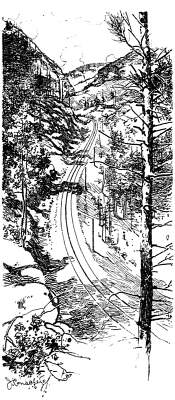 IT has
long been an axiom among engineers that no task of construction
is beyond their skill if only sufficient money be provided. Nothing
illustrates this more forcefully and more practically IT has
long been an axiom among engineers that no task of construction
is beyond their skill if only sufficient money be provided. Nothing
illustrates this more forcefully and more practically 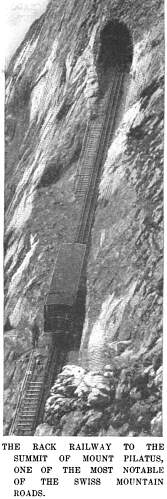 than the building of railroads that traverse
mountains. Over and over again it has been proven that there are
no natural obstacles that cannot be overcome. The traveler who
shudders when be looks down hundreds of feet from a car window,
or scowls when he is rushed into a tunnel, seldom understands
at what terrific cost his comfort was bought. Neither does he
realize the dangers which actually surround him, and the small
things upon which his life depends. If he did, he would probably
be panic stricken. than the building of railroads that traverse
mountains. Over and over again it has been proven that there are
no natural obstacles that cannot be overcome. The traveler who
shudders when be looks down hundreds of feet from a car window,
or scowls when he is rushed into a tunnel, seldom understands
at what terrific cost his comfort was bought. Neither does he
realize the dangers which actually surround him, and the small
things upon which his life depends. If he did, he would probably
be panic stricken.
The safe running of a train over an ordinary division requires
an almost infinite amount of care and vigilance, not only In the
present, but in the past as well, beginning from the time when
the engineers were surveying and locating the line. The choice
of a route may mean the future courting or avoidance of a disaster.
There must be knowledge of the geological formation of the ground
over which the track is to he laid, and its risk of exposure to
freshets, subsidences, landslides, avalanches, and snow blockades.
Past performances must be the data upon which future good or bad
behavior must be predicated, and it is upon the intimacy of his
knowledge with that past that the work of the engineer is to be
judged.
In a country that has been peopled for generations, the work
of the engineer is greatly facilitated: but where he must strike
out into new territory—where he must draw conclusions from
such knowledge as he can extort from nature itself or can gather
front the hazy, rambling talk of the savage or the mountaineer—here
his ability, perseverance, and judgment must be of the highest
order.
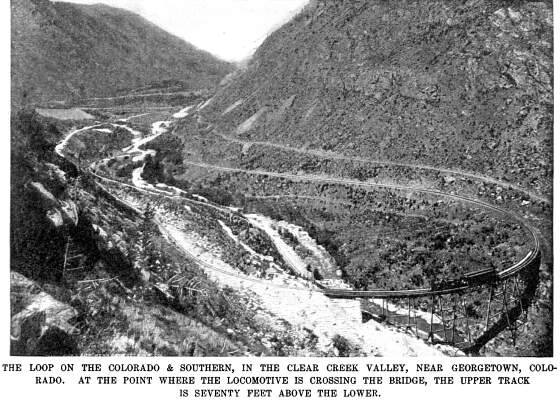
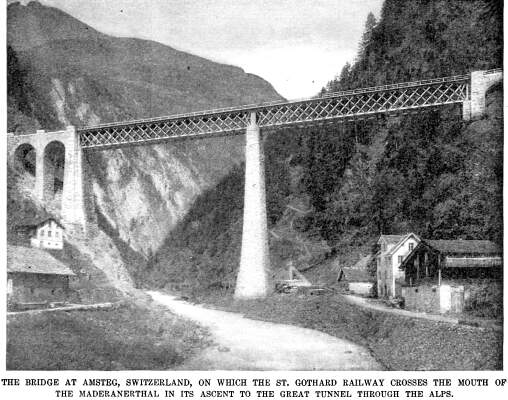
RAILROAD PIONEERS IN THE WEST.
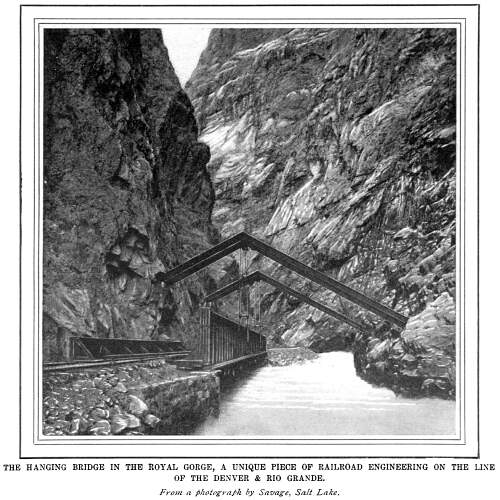 In few countries
has the railroad builder been asked to overcome such difficulties
as in the mountains of the Western States and Canada. Crossing
the border between civilization and savagery he has pushed his
lines in advance of the frontier settlements, fighting with the
wildest of elements, beasts, and men for every foot. He has followed
mountain torrents to their sources, climbed peaks where the white
man had never stood before; explored canyons which the Indians
said no man could enter and come out alive; dangled by ropes over
precipices and painted his marks on the living rock, because there
was no crevice in which to drive a stake. In one case, at least,
he has taken his railroad over a mountain pass in advance even
of the Indian's trail. All these things have been done far from
any base of supplies. He has been cut off from civilization for
months at a time and has lived on the rifles of his hunters, while
searching for the best way to reach his destination, and guarding
constantly against a treacherous and malignant foe. Only by such
toil and suffering has he driven his stakes to mark the route
over which the thoughtless occupant of the parlor car shall afterwards
roll in comfort and luxury. In few countries
has the railroad builder been asked to overcome such difficulties
as in the mountains of the Western States and Canada. Crossing
the border between civilization and savagery he has pushed his
lines in advance of the frontier settlements, fighting with the
wildest of elements, beasts, and men for every foot. He has followed
mountain torrents to their sources, climbed peaks where the white
man had never stood before; explored canyons which the Indians
said no man could enter and come out alive; dangled by ropes over
precipices and painted his marks on the living rock, because there
was no crevice in which to drive a stake. In one case, at least,
he has taken his railroad over a mountain pass in advance even
of the Indian's trail. All these things have been done far from
any base of supplies. He has been cut off from civilization for
months at a time and has lived on the rifles of his hunters, while
searching for the best way to reach his destination, and guarding
constantly against a treacherous and malignant foe. Only by such
toil and suffering has he driven his stakes to mark the route
over which the thoughtless occupant of the parlor car shall afterwards
roll in comfort and luxury.
The early railroad work in the Rocky Mountains stands unique
in the history of the science, in that it was the advance guard
of civilization, and was called upon to solve entirely new problems
and work out its own salvation in its own way, with little or
no 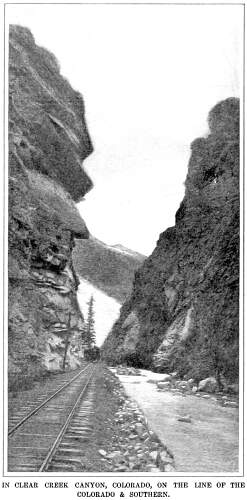 suggestive
help from what bad gone before. Given sufficient capital, a railroad
between almost any two points becomes a possibility; but even
when the road has been built over the most careful of surveys,
its operation may present difficulties as great as those encountered
in the work of exploration and construction. This is especially
true of the roads in the higher altitudes, where snow falls during
the greater part of the year, and where the winter accumulation
is so great as to defy the management to maintain a clear-track,
even avalanches and "flurries" were unknown. suggestive
help from what bad gone before. Given sufficient capital, a railroad
between almost any two points becomes a possibility; but even
when the road has been built over the most careful of surveys,
its operation may present difficulties as great as those encountered
in the work of exploration and construction. This is especially
true of the roads in the higher altitudes, where snow falls during
the greater part of the year, and where the winter accumulation
is so great as to defy the management to maintain a clear-track,
even avalanches and "flurries" were unknown.
FIGHTING SNOW IN THE ROCKIES
As a result of these conditions, all the Rocky Mountain roads
are provided with snowsheds. These are not mere coverings to protect
the road from a gentle fall of snow, but substantial structures,
that would compare in strength with many an old fortification
intended to withstand the assaults of artillery. They may be designed
merely to carry a dead weight of snow, or to withstand the terrific
action of avalanches upon one or both sides. When the avalanche
is to be guarded against, the mountain side of the shed is built
of a cribwork of timbers twelve inches square, and filled in at
the back with solid rock, designed to carry the snow over the
roof of the shed without permitting the moving mass to strike
heavily against it. The outer edge of the roof is supported by
heavy timbers. Such sheds cost from forty to seventy dollars a
foot, according to circumstances.
Long sheds are objectionable, because their cost is great,
and because gases from the locomotive gather in them. Therefore
the sheds are usually built in sections, made as short as possible.
The openings are protected by "glance works," or "split
fences," intended to divert the course of the sliding mass
of snow, ice, and rocks. These are V shaped fences, the apex pointing
up the mountainside, which throw the descending debris to the
right or left so that it will pass over the sheds. Sometimes one
of these barricades is insufficient, and others are built farther
up the slope. They are of cribwork or piles, strengthened by a
filling of rock work.
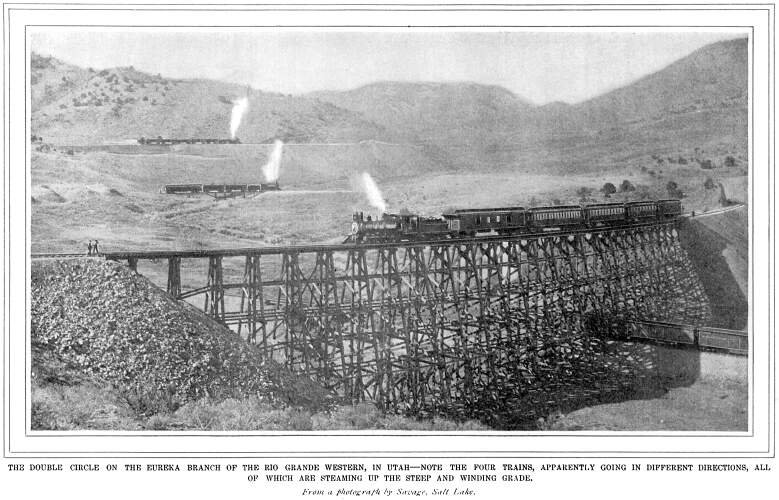
Where the Canadian Pacific passes the crest of the Rocky Mountains,
there are about six miles of snowsheds, containing twenty five
million feet of sawed timber, and one million, one hundred and
forty thousand lineal feet of round timber. The snowfall in that
region is at times very great. In the winter of 1886-87 it was
thirty five feet in the Selkirk range; eight and a half feet fell
in six days. At that time the snowsheds were buried under fifty
feet of snow, so compacted that it weighed thirty pounds to the
cubic foot.
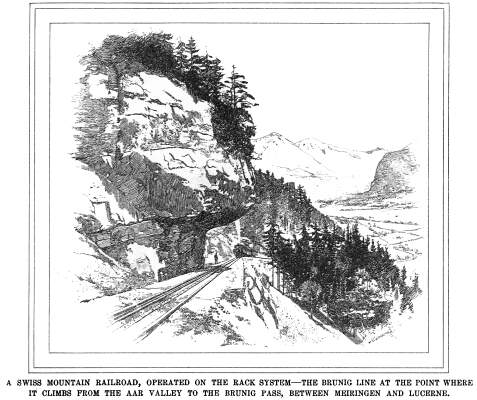 If the railroads
had to contend only with the snow as it fell, they would seldom
have much trouble. But it may be melted by the Chinook winds and
winter rains, and then there may come a sudden fall of the temperature
to thirty degrees below zero, making a compact mass of snow and
ice that only blasting can remove. More dangerous and harder to
control is the "awful avalanche," which may come down
the mountainside so gently and so quietly as to cause no pressure,
no strain, no disaster, or it may start far up the slope, and,
gathering force as it descends, hurl down a huge mass of snow,
ice, rocks, and uprooted trees weighing a quarter of a million
tons. It moves with the roar of a volcano and the speed of a cyclone,
shaking the earth in its progress and sweeping everything before
it, a spectacle of awful magnificence when viewed from a safe
distance. In its mad rush, the avalanche makes a "flurry,"
a local cyclone, which sometimes extends for a distance of a hundred
yards outside its path. This fierce blast of air uproots or snaps
off trees that rise a hundred and fifty feet from the ground. If the railroads
had to contend only with the snow as it fell, they would seldom
have much trouble. But it may be melted by the Chinook winds and
winter rains, and then there may come a sudden fall of the temperature
to thirty degrees below zero, making a compact mass of snow and
ice that only blasting can remove. More dangerous and harder to
control is the "awful avalanche," which may come down
the mountainside so gently and so quietly as to cause no pressure,
no strain, no disaster, or it may start far up the slope, and,
gathering force as it descends, hurl down a huge mass of snow,
ice, rocks, and uprooted trees weighing a quarter of a million
tons. It moves with the roar of a volcano and the speed of a cyclone,
shaking the earth in its progress and sweeping everything before
it, a spectacle of awful magnificence when viewed from a safe
distance. In its mad rush, the avalanche makes a "flurry,"
a local cyclone, which sometimes extends for a distance of a hundred
yards outside its path. This fierce blast of air uproots or snaps
off trees that rise a hundred and fifty feet from the ground.
So rapid is the movement of the avalanche that sometimes, when
the railroad sheds have been broken in and filled with debris,
large vacant spaces have been found in the mass, showing where
air has been caught and imprisoned by the falling snow. With such
natural terrors to contend with, it was a wise provision on the
part of the railroad authorities to provide each dining car on
its through trains with an emergency box, to be opened only as
a last resort, and to store food in caches along the line at intervals
of ten or twelve miles, in imitation of the hunters of the Hudson
Bay Company.
IN THE WESTERN CANYONS.
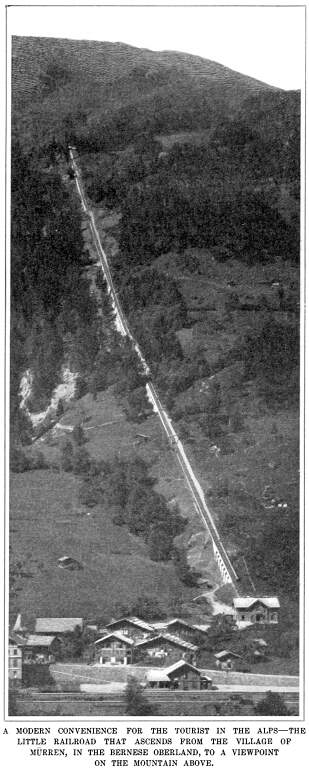 But snowsheds
are not the only interesting engineering features of the Rocky
Mountain roads. We find tracks running on shelves along the faces
of unscalable cliffs; they follow the windings of deep canyons;
they skirt great hills, and everywhere the work is one of might
and power. There is more romance in the building of these mountain
railroads than in the tales of chivalry; there are more adventurous
experiences and hairbreadth escapes than the inventive minds of
story writers ever conceived. There are a devotion, a pluck, and
an indomitable energy coupled with engineering genius That make
the deeds of the old knights seem puny and trivial. Take the story
of the Royal Gorge, where there is room but for one road, where
it was a matter of life and death to secure the right of way and
the surveyor's transit was ever guarded by the rifle. This was
the only route from Canyon City to Leadville, and a right royal
route it is. Here the Arkansas River emerges from the rocky fastnesses
in its wild plunge from the mountains to the plains, after a twelve
miles' course between cliffs rising three thousand feet in the
sheer, and with barely room between them for the tumbling waters
of the river. Through this wild canyon of mica, green serpentine,
and red sandstone the railroad edges its way up and up, disputing
with the water for every foot of the path, until, at last, at
the hanging Bridge, it leaves the whole width of the gorge to
the water, and crosses the stream on a plate girder bridge, one
side of which is suspended from a truss that has a footing on
either side of the lofty canyon walls. But snowsheds
are not the only interesting engineering features of the Rocky
Mountain roads. We find tracks running on shelves along the faces
of unscalable cliffs; they follow the windings of deep canyons;
they skirt great hills, and everywhere the work is one of might
and power. There is more romance in the building of these mountain
railroads than in the tales of chivalry; there are more adventurous
experiences and hairbreadth escapes than the inventive minds of
story writers ever conceived. There are a devotion, a pluck, and
an indomitable energy coupled with engineering genius That make
the deeds of the old knights seem puny and trivial. Take the story
of the Royal Gorge, where there is room but for one road, where
it was a matter of life and death to secure the right of way and
the surveyor's transit was ever guarded by the rifle. This was
the only route from Canyon City to Leadville, and a right royal
route it is. Here the Arkansas River emerges from the rocky fastnesses
in its wild plunge from the mountains to the plains, after a twelve
miles' course between cliffs rising three thousand feet in the
sheer, and with barely room between them for the tumbling waters
of the river. Through this wild canyon of mica, green serpentine,
and red sandstone the railroad edges its way up and up, disputing
with the water for every foot of the path, until, at last, at
the hanging Bridge, it leaves the whole width of the gorge to
the water, and crosses the stream on a plate girder bridge, one
side of which is suspended from a truss that has a footing on
either side of the lofty canyon walls.
Again, in the canyon of the Rio de las Animas Perdidas (the
River of Lost Souls) the Denver & Rio Grande, after following
the bed of the river for about fifteen miles from Silverton, plunges
into the gorge. At first, the road is but a few feet above the
level of the stream; then the grades become steeper, the curves
sharper, the surroundings wilder, until, almost before the passenger
is aware, the train is running along a shelf cut in the face of
the cliff, with the river a ribbon of foam and mist hundreds of
feet below.
A photograph gives only a faint idea of the engineering difficulties
encountered in the construction of a line where there was hardly
a chance for the setting of the tripod of the transit. Indeed,
in some of the Colorado canyons the location was determined by
triangulation, because of the absolute inaccessibilitv of the
route, which was to run where no living being but the birds of
the air had been before. Such work, like many other great enterprises,
would have been commercially impossible before the discovery of
the nitroglycerin compounds. The successful use of nitroglycerin
in the work of the Hoosac tunnel led to the later production of
dynamite, a safer compound to handle; and this, in turn, has given
way, to a great extent, to the glycerin gelatine, which will endure
a still greater amount of rough treatment without exploding.
THE LOOP AND THE SWITCHBACK.
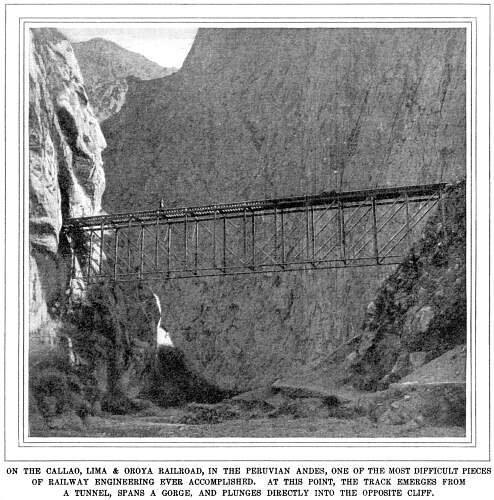 Interesting
as the canyon work is from an engineering standpoint, laborious
as the task of blasting may have been, and picturesque, as the
results of these cuttings undoubtedly are, as the photographs
show, they constitute but a small part of the work of the railroad
builder. Where a mountain has to be climbed, and the entering
valley is narrow and steep, and where the side valleys cannot
be used to lengthen the line and ease the grades, the engineer
must resort to such devices as the switchback and the loop. The
former is a simple expedient for zigzagging up a mountainside.
The track runs up the valley until the mountain blocks the way;
it then starts back in the opposite direction, and climbs higher
until it is again stopped, perhaps by a precipitous slope, perhaps
by the ending of the spur upon which it rests. Again its direction
is reversed, and this method is continued until a point is reached
where it is high enough to reach the crest of the divide, so that
it can go its way without let or hindrance. Interesting
as the canyon work is from an engineering standpoint, laborious
as the task of blasting may have been, and picturesque, as the
results of these cuttings undoubtedly are, as the photographs
show, they constitute but a small part of the work of the railroad
builder. Where a mountain has to be climbed, and the entering
valley is narrow and steep, and where the side valleys cannot
be used to lengthen the line and ease the grades, the engineer
must resort to such devices as the switchback and the loop. The
former is a simple expedient for zigzagging up a mountainside.
The track runs up the valley until the mountain blocks the way;
it then starts back in the opposite direction, and climbs higher
until it is again stopped, perhaps by a precipitous slope, perhaps
by the ending of the spur upon which it rests. Again its direction
is reversed, and this method is continued until a point is reached
where it is high enough to reach the crest of the divide, so that
it can go its way without let or hindrance.
The loop requires more room than switchback, and is used in climbing
where the valley is broader.
Probably the best known loop in the West is that of the Colorado
& Southern Railway, near Georgetown. Before reaching this
point, the road doubles back on itself twice, crossing Clear Creek
on each turn. Then it passes on to the loop, where it turns, crosses
the creek twice more, and passes beneath itself, with a distance
of seventy five feet between the upper and the lower line of rails,
running nearly four miles to secure an advance of two. This section
has an average grade of one hundred and sixty feet to the mile,
with a maximum of one hundred and ninety.
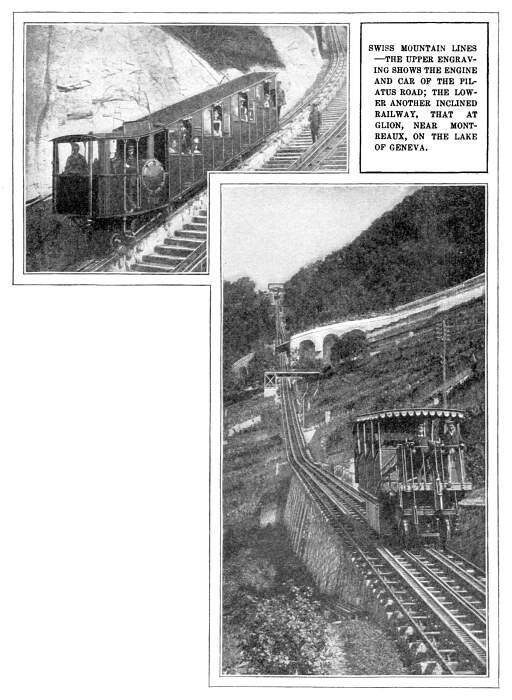
Sometimes the engineer is confronted with alternative courses.
He may be able to make a long detour, by which he can pass along
the side and across the head of a valley in order to reach the
opposite slope; or he can build a viaduct straight across as the
bird would fly. It then becomes a matter of cold blooded calculation
as to which would be the better investment. The viaduct, of course,
will cost more to build, but it may shorten the line by several
miles, and every train that crosses it will save time and money.
Careful estimates of the first cost of each plan are made, and
of the probable expense of operation and maintenance in view of
the traffic that may be expected. If the viaduct can show a saving
in operating expenses more than sufficient to pay interest on
its added first cost, the matter is settled, and the structure
is erected.
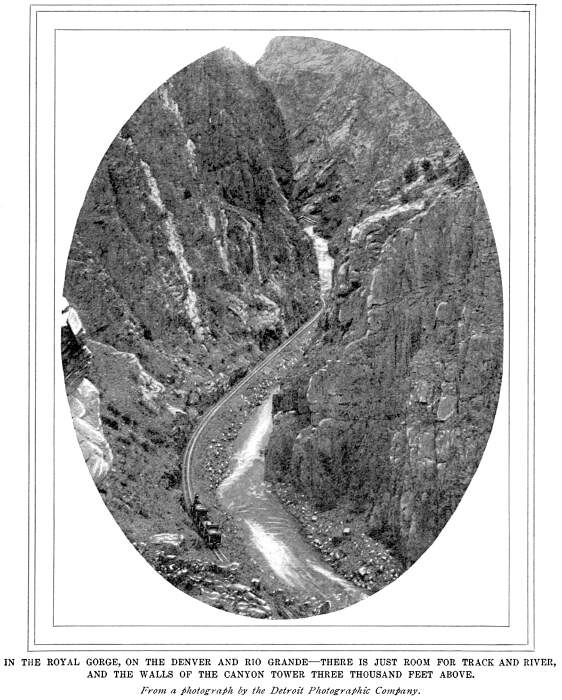 Thus the railroads
have been led over untrodden mountain passes, and through canyons
that for centuries had echoed only to the roar of cataracts and
rapids, but whose rocks now reverberate to the rumble of the fast
express. They have threaded valleys by the eagle's route, and
plunged through the granite of the everlasting hills by tunnels
that are but pin pricks in their rugged sides. Thus the railroads
have been led over untrodden mountain passes, and through canyons
that for centuries had echoed only to the roar of cataracts and
rapids, but whose rocks now reverberate to the rumble of the fast
express. They have threaded valleys by the eagle's route, and
plunged through the granite of the everlasting hills by tunnels
that are but pin pricks in their rugged sides.
And when these things have been done still bolder schemes are
accomplished. A great peak is climbed by grades on which no smooth
faced wheel could roll, and the rack is used to hold and force
the train ahead. The rack system was first planned by a German
engineer for the Rigi, the mountain familiar to all tourists who
visit Lucerne; but the Swiss project was delayed, and before any
of the proposed road was constructed, a line of the same type
was built and put into operation on Mount Washington, in New Hampshire.
Some years later, a similar road reached the still loftier summit
of Pike's Peak, making the climb of that Western giant a mere
holiday trip, to be taken with the same blasé indifference
as the journey across the continent or the ocean.
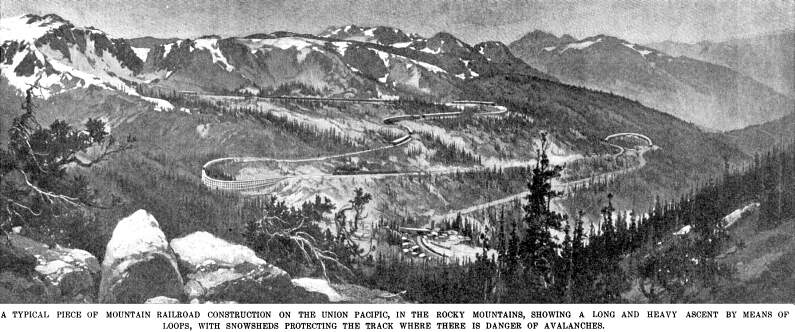
THE HIGHEST RAILROAD IN THE WORLD.
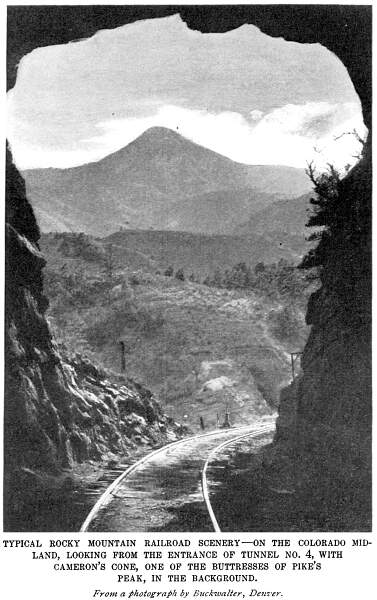 Our mountain
roads are great in the difficulties that they have surmounted,
and the energy with which they have been pushed to remote fastnesses
where nature seemed unconquerable. But wherever civilization has
settled, and wherever the miner has gone, there the railroad has
followed. In South America, especially among the Peruvian Andes,
mountain railroading has many examples of fine engineering to
show. In fact, there are places where the work done is unprecedented
in the history of the profession. The Callao, Lima & Oroya
Railroad famed throughout the world. Starting from the Pacific
Ocean, it follows the broad valley of the Rimac up past Lima to
Chosica, where the converging spurs of the Cordilleras crowd it
to a width of a thousand yards. Thence, in the tortuous defiles
of the Rimac the road climbs with a four percent grade, and over
curves of three hundred and fifty feet radius; it crosses and
recrosses The Rio Seco and spans a deep mountain gorge on the
famous Verrugas viaduct—a structure which, at a distance,
appears far too delicate for practical railroad work, but which
shows no appreciable deflection under the heaviest locomotives
on the road. Still up and up the track climbs, with detour after
detour, until, near Surco, there are three tunnels directly over
one another. But the heights to be scaled still reach on and on
until the Rimac gorge is crossed; thence we pass up a zigzag to
tunnel No. 14. Here the laying out of the line presented stupendous
difficulties and dangers. The men were lowered over the cliffs
from bench to bench cut from the naked faces of the rock, until
the levels were reached. Our mountain
roads are great in the difficulties that they have surmounted,
and the energy with which they have been pushed to remote fastnesses
where nature seemed unconquerable. But wherever civilization has
settled, and wherever the miner has gone, there the railroad has
followed. In South America, especially among the Peruvian Andes,
mountain railroading has many examples of fine engineering to
show. In fact, there are places where the work done is unprecedented
in the history of the profession. The Callao, Lima & Oroya
Railroad famed throughout the world. Starting from the Pacific
Ocean, it follows the broad valley of the Rimac up past Lima to
Chosica, where the converging spurs of the Cordilleras crowd it
to a width of a thousand yards. Thence, in the tortuous defiles
of the Rimac the road climbs with a four percent grade, and over
curves of three hundred and fifty feet radius; it crosses and
recrosses The Rio Seco and spans a deep mountain gorge on the
famous Verrugas viaduct—a structure which, at a distance,
appears far too delicate for practical railroad work, but which
shows no appreciable deflection under the heaviest locomotives
on the road. Still up and up the track climbs, with detour after
detour, until, near Surco, there are three tunnels directly over
one another. But the heights to be scaled still reach on and on
until the Rimac gorge is crossed; thence we pass up a zigzag to
tunnel No. 14. Here the laying out of the line presented stupendous
difficulties and dangers. The men were lowered over the cliffs
from bench to bench cut from the naked faces of the rock, until
the levels were reached.
The engineers were swung across the gorges on wire ropes stretching
from side to side. In one run of fifteen miles, there are twenty
two tunnels. At another point five parallel lines, hundreds of
feet above one another, are visible from any point in the valley,
three on one side and two on the other, while the greatest horizontal
distance between any two of them is fewer than five hundred feet.
Still it is up, up, to the head of the Rimac, which is inclosed
by unscalable cliffs, to overcome which seven tunnels had to be
constructed. At last, the road found itself amid a desolation
of snow and ice just below the dividing crest of the Andes. One
more boring, and then the Galera tunnel, 3,847 feet long and 15,645
feet above the sea, leads to the comparatively easy stretch down
to Oroya, the inland terminus.
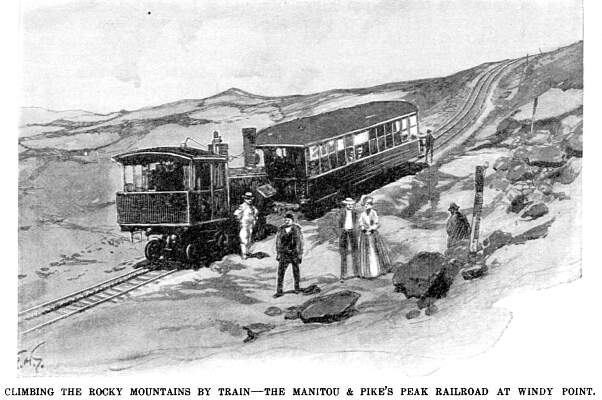
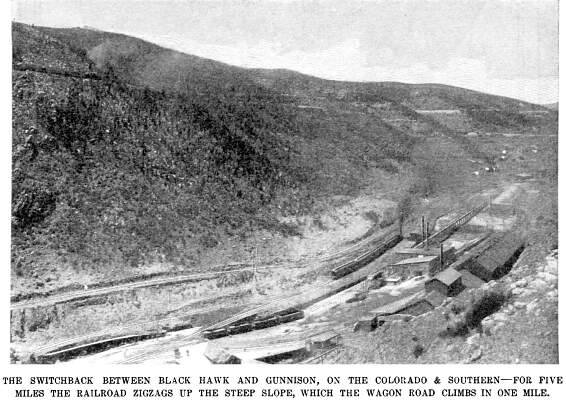
Such, then, is a brief review of what the quiet man with the
transit has done to annihilate space and time; to rob mountain
climbing of its fatigues and dangers; to roll a panorama of beauty
and grandeur and sublimity before the eyes of those who would
otherwise never see it. He sets his goal wherever man desires
to go, and with courage, patience, and indomitable energy, amid
toil and hardship, he has marked out and built the road over which
his fellows may follow him in ease and luxury.
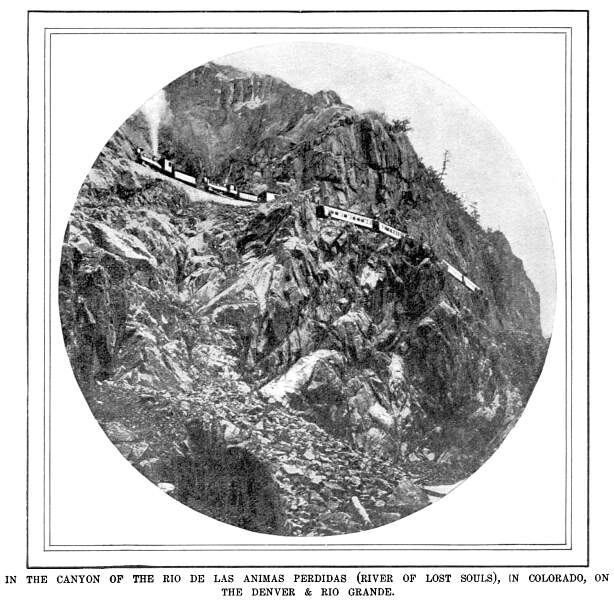
Mountain Railroading
| Contents Page
|







